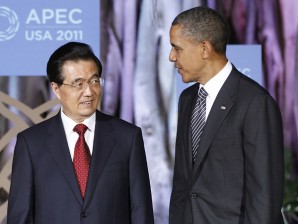Obama outlines Pacific vision at APEC summit
HONOLULU – US President Barack Obama laid out his vision Sunday of a “seamless” trans-Pacific trade zone that could re-energize global growth as he opened a regional summit in his native Hawaii.

U.S. President Barack Obama greets Chinese President Hu Jintao before the APEC leaders dinner in Honolulu, on Saturday. AP Photo
Boosted by Japan’s entry into talks on the US-led Trans-Pacific Partnership (TPP), which could become the world’s largest free trade area, Obama said harnessing the huge trade potential of the dynamic region was vital.
“Today we have got a chance to make progress towards our ultimate goal which is a seamless regional economy,” Obama told leaders at theAsia-Pacific Economic Cooperation (APEC) forum, which accounts for more than half the world’s GDP.
“I want to emphasize that the Asia-Pacific region is absolutely critical to America’s economic growth,” Obama said.
“We consider it a top priority. And we consider it a top priority because we’re not going to be able to put our folks back to work and grow our economy and expand opportunity unless the Asia-Pacific region is also successful.”
But the president, who has dubbed himself America’s first Pacific president, has balanced his calls for regional unity with a challenge to emerging economic superpower China to observe developed world trade standards.
Article continues after this advertisementObama, seeking re-election next year as many heartland Americans think they lost their jobs to lower-wage China, told President Hu Jintao on Saturday that Americans were “impatient” for a change in Beijing’s economic policy.
Article continues after this advertisementWashington says that China keeps its yuan currency artificially low to boost its exports and complains that Beijing is lax on intellectual property standards, penalizing US innovation.
A US official said that Obama and Hu would hold a second, informal meeting on the sidelines of the APEC leaders gathering on Sunday before Obama ends the weekend gathering in palm-fringed Hawaii with a press conference.
The Trans-Pacific Partnership, or TPP, would strike down tariffs and trade barriers and inject momentum to liberalization hopes bogged down by inconclusive talks on the Doha trade round.
The pact, which Obama hopes will be formalized next year, got a massive boost on the eve of the summit when new Japanese Prime Minister Yoshihiko Noda committed himself to entering negotiations.
“I have been extremely impressed already with the boldness of his vision,” Obama said after meeting Noda Saturday.
The TPP was signed in 2005 as an obscure agreement among Brunei, Chile, New Zealand and Singapore. Obama suddenly turned it into the cornerstone of US free trade drive, with Australia, Japan, Malaysia, Peru, the United States and Vietnam now also in the talks.
In a joint statement, leaders of TPP nations said they shared a “strong interest” in expanding their membership.
The major outlier of the TPP is China, the world’s second largest economy.